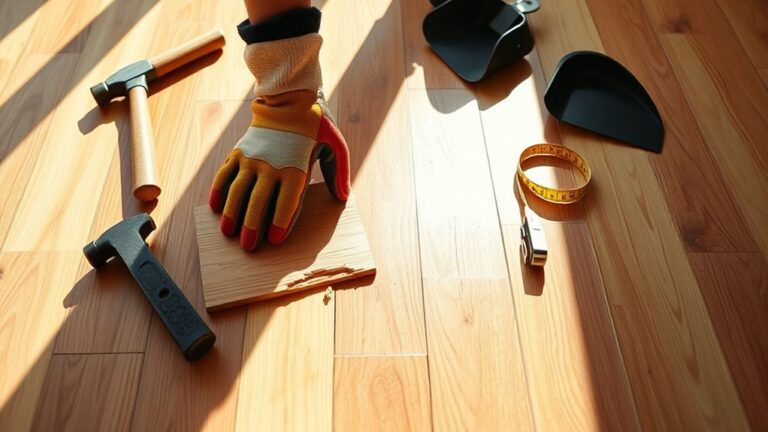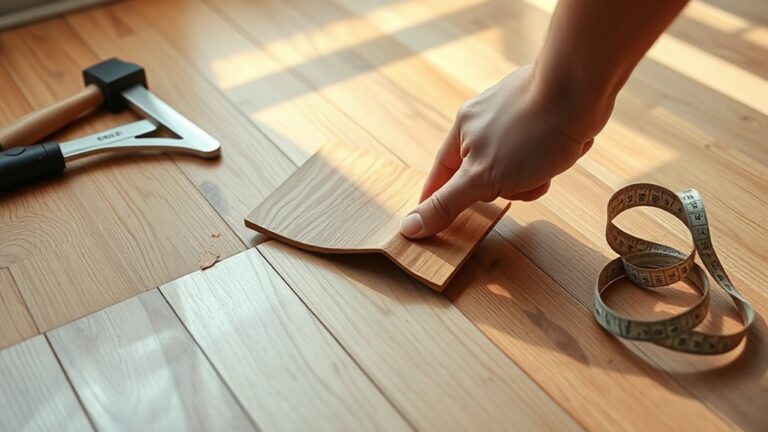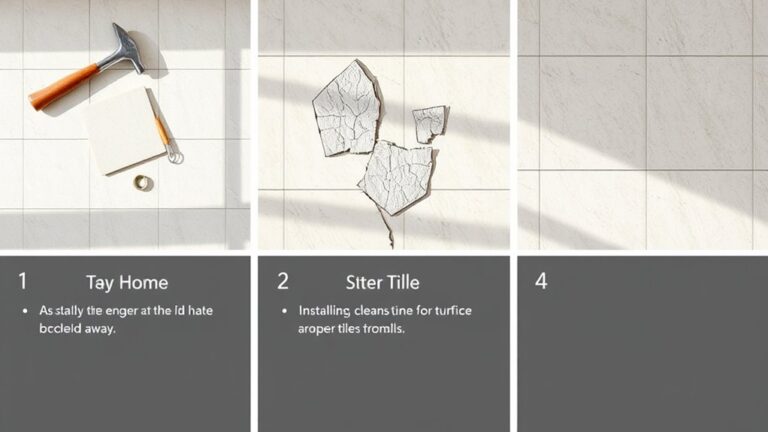To maintain your stamped concrete floors, start with regular cleaning to prevent dirt buildup. Sweep or blow off debris, then clean with warm water and mild dish soap. For tougher stains, an alkaline cleaner works well, but always rinse thoroughly. Reseal every 2 to 3 years to protect against moisture and freeze-thaw cycles. During winter, use safe snow melters and avoid sand. Be cautious with heavy furniture; lift instead of dragging to prevent scratches. Also, manage humidity levels to avoid discoloration. If you're curious about additional tips and techniques, there's more to explore!
Importance of Regular Cleaning
When it comes to maintaining the beauty and durability of your stamped concrete floors, regular cleaning is essential. Neglecting this critical step can lead to dirt buildup, resulting in unsightly stains and surface deterioration over time. To preserve the aesthetic appeal of your stamped surface, routine cleaning and maintenance practices must be implemented. Start with simple tasks like sweeping and rinsing with a garden hose to keep the surface free from debris that can scratch or etch the finish.
Using pH-neutral cleaners during your washing routine is imperative. These cleaners effectively remove grime without compromising the integrity of the stamped surface. Stubborn stains should be addressed promptly with appropriate cleaning agents; if left unattended, they may become permanent marks on your concrete, diminishing its overall appearance.
Effective Cleaning Techniques
To maintain your stamped concrete floor's appearance, routine cleaning practices are essential. Start by sweeping or using a leaf blower to clear away debris, then tackle tougher stains with warm water and mild dish soap. For stubborn stains, consider alkaline cleaners or power washing, but always follow the manufacturer's guidelines to prevent damage.
Routine Cleaning Practices
Over time, maintaining the pristine look of your stamped concrete floors hinges on effective routine cleaning practices. To guarantee your stamped concrete surface remains vibrant and free from debris, establish a consistent cleaning schedule, ideally every few weeks. Here are the essential steps for routine cleaning:
- Sweep or Blow: Regularly sweep or use a leaf blower to remove loose debris, preventing dirt buildup and potential staining.
- Wash: Use a garden hose on high pressure to wash the surface, guaranteeing dirt and grime are lifted.
- Scrub: Follow up with a push broom and a mild dish soap solution to enhance cleanliness.
- Rinse Thoroughly: Always rinse well to eliminate all soap residue; leftover cleaner can lead to haziness and deterioration over time.
- Tackle Tough Stains: For stubborn stains like tire marks or grease, consider using alkaline cleaners or a pressure washer, but be cautious to avoid damaging the sealer.
Stain Removal Methods
Even with regular cleaning, stains can still occur on stamped concrete floors, requiring effective removal techniques to restore their original appearance. Start with warm water and a mild detergent, gently scrubbing the area to lift most stains with minimal effort. For oil and grease stains, alkaline cleaners excel in breaking them down without damaging the surface.
If stubborn stains persist, power washing can be beneficial, but always follow the manufacturer's instructions to protect the sealer layer. For particularly tough marks like rust or deep-set grease, professional assistance might be necessary, as standard cleaning methods often won't suffice.
To help you navigate various stain removal methods, here's a handy reference:
| Stain Type | Recommended Method |
|---|---|
| General Stains | Warm water and mild detergent |
| Oil and Grease | Alkaline cleaners |
| Stubborn Stains | Power washing (with caution) |
Always remember to rinse the surface thoroughly with clean water after using any cleaning agents. This prevents residue buildup that can dull your floor's surface over time, ensuring your maintenance efforts pay off.
Sealing Your Stamped Concrete
Maintaining the integrity and beauty of your stamped concrete requires regular attention, particularly when it comes to sealing. Sealing your decorative concrete not only enhances its appearance but is essential for protecting it from moisture penetration, freeze-thaw cycles, and damage from de-icing chemicals. Typically, you should plan to reseal your concrete every 2 to 3 years to guarantee ideal protection.
Before you start sealing, make sure the surface is completely dry. Ideally, allow 24 hours for drying, or you can speed up the process using a leaf blower. When you're ready to apply the sealer, follow these steps for best results:
- Use a 1-inch nap roller to apply the sealer in manageable 2 x 4 sections.
- Ensure even coverage to maximize both protection and visual appeal.
- Consider adding an anti-skid additive to your sealer for improved traction, especially in wet conditions.
- Always adhere to the manufacturer's instructions regarding application and drying times.
- If you're unsure, consulting with a professional contractor can provide valuable guidance.
Seasonal Maintenance Tips
After ensuring your stamped concrete is properly sealed, seasonal maintenance becomes essential to preserving its aesthetics and functionality. Start by checking the seal every two years; this isn't just a guideline, but a necessity to maintain the integrity of your concrete and prevent deterioration due to environmental factors.
During the spring and summer, monitor humidity levels closely. High humidity can lead to moisture buildup under the sealer, causing unsightly white stains and potential damage. If you notice any signs of trapped moisture, it's important to address it promptly through thorough concrete cleaning. This will help maintain the beauty and longevity of your stamped surface.
As fall approaches and winter sets in, switch your maintenance strategy. Use safe snow and ice melters to prevent damage to your concrete during icy conditions. Avoid using sand or caustic substances, as these can scratch or degrade the surface over time.
In high-traffic areas, timely re-sealing is essential. Not only does it prevent excessive wear, but it also helps maintain the vibrancy of your concrete's color. Remember, seasonal maintenance isn't just about aesthetics; it's about ensuring your stamped concrete remains a stunning feature of your home for years to come. Regular upkeep, from monitoring humidity levels to seasonal cleaning, will empower you to enjoy your stamped concrete's beauty without worry.
Protecting Against Stains
To protect your stamped concrete from stains, it's essential to manage moisture accumulation effectively. Redirect sprinklers and avoid rubber-backed mats that can trap moisture, as these can lead to discoloration over time. Additionally, be mindful of fertilizer runoff from plants, as it can damage the concrete's sealer and result in unsightly stains.
Preventing Moisture Accumulation
When it comes to preventing moisture accumulation on stamped concrete, several proactive measures can greatly reduce the risk of stains and surface damage. It's important to seal your concrete surfaces with a high-quality surface sealer to create a protective barrier. Here are some essential tips to help you maintain dry, stain-free stamped concrete:
- Elevate permanent objects above the concrete surface to enhance airflow and prevent moisture buildup.
- Regularly redirect sprinklers away from stamped concrete to minimize excessive moisture exposure.
- Avoid using rubber-backed mats, as they restrict airflow and can trap moisture, leading to staining and deterioration of the sealer.
- Monitor humidity levels in your environment to prevent moisture buildup under the sealer, which can result in unsightly white stains.
- Implement proper drainage solutions around stamped concrete areas to guarantee water runoff is directed away, preventing pooling and related staining issues.
Using Proper Mats
Proper mat selection is essential for protecting stamped concrete from stains and damage. When you're using proper mats, opt for those with an open weave design. This promotes air circulation, preventing moisture buildup that can lead to staining and deterioration of your beautiful concrete surface. Avoid rubber-backed mats, as they trap moisture against the concrete, restricting airflow and increasing the risk of mold and mildew.
Elevate permanent objects like furniture or decor to allow for better airflow underneath. This simple step can greatly reduce the chance of moisture-related stains. Additionally, be mindful of your sprinkler systems; redirect them to limit excessive water exposure, as constant moisture can discolor and deteriorate the concrete sealer.
Regular maintenance is key, so make it a habit to clean and dry your mats frequently. This prevents dirt buildup and debris transfer onto the stamped concrete surface, which can lead to staining and wear over time. By taking these precautions, you can keep your stamped concrete looking stunning and prolong its lifespan, ensuring it remains a beautiful feature in your space for years to come.
Managing Fertilizer Runoff
Regularly managing fertilizer runoff is essential for protecting your stamped concrete surfaces from unsightly stains. When fertilizers wash away during rain, they can leave behind marks that detract from the beauty of your stamped concrete patio. Here are some practical steps to help you prevent these issues:
- Properly manage landscaping: Verify that nearby plants are well-maintained to minimize excess fertilizer runoff.
- Elevate objects: Raise permanent items like planters or decorative stones above the concrete to promote airflow and reduce moisture-related stains.
- Avoid rubber-backed mats: These can trap moisture and restrict airflow, leading to staining from fertilizers.
- Redirect sprinkler systems: Adjust your irrigation to avoid oversaturating your stamped concrete, as excessive moisture can worsen staining.
- Implement a cleaning routine: Regularly clean your surfaces using a neutral pH cleaner to effectively remove any residue before it penetrates.
Common Mistakes to Avoid
Maintaining your stamped concrete floor requires vigilance to avoid common mistakes that can lead to costly repairs. One significant error is using harsh cleaners like acid or vinegar. These substances can etch the surface, causing discoloration and diminishing the aesthetic appeal of your stamped concrete. Stick to mild soaps and pH-balanced cleaners instead.
Another common oversight is neglecting regular resealing every 2-3 years. Failing to maintain stamped concrete in this way can result in moisture penetration, leading to deterioration of both the color and integrity of your flooring. Make sure you incorporate resealing into your maintenance schedule.
When it comes to heavy furniture, be cautious. Dragging these items across the surface can scratch and damage the finish. Instead, lift items or use furniture pads to protect your stamped concrete. Additionally, avoid letting debris, such as leaves or tarps, sit on the surface for extended periods. This can trap moisture and lead to staining or discoloration, making it essential to clear the area regularly.
Professional Maintenance Services
While avoiding common mistakes is critical for the upkeep of your stamped concrete, enlisting the help of professional maintenance services can take your care routine to the next level. These services typically encompass a range of essential tasks designed to retain the beauty and functionality of your surfaces. By engaging skilled professionals, you guarantee that your concrete receives the best care possible.
Here are some key benefits of hiring professional maintenance services:
- Regularly cleaning to remove dirt and debris, preventing surface damage.
- Expert sealing using the best sealer available, which protects against moisture and wear.
- Periodic inspections to identify potential issues, allowing for timely repairs before they escalate.
- Tailored maintenance programs that cater to the specific conditions of your site.
- Resealing every 2-3 years to maintain color and sheen, guaranteeing a lasting aesthetic appeal.
Frequently Asked Questions
How to Maintain Stamped Concrete?
To maintain stamped concrete, you should regularly clean the surface to prevent dirt buildup and staining. Resealing every 2-3 years is essential for protecting the vibrant stamped concrete colors and ensuring longevity. Pay attention to any signs of wear, as timely stamped concrete repair can prevent further damage. During installation, choose high-quality materials to enhance the benefits of stamped concrete, creating a durable and beautiful surface that complements your lifestyle.
How Often Should You Seal Stamped Concrete?
Sealing stamped concrete's like giving your driveway a protective coat against the elements. You should aim for sealing every 2 to 3 years, but weather impact and heavy foot traffic can influence this frequency. Before applying a sealer, verify proper surface preparation by cleaning and drying thoroughly. Opt for high-quality sealer types designed specifically for stamped concrete to enhance durability and maintain that appealing look over time. Regular checks can help you determine when it's time to reseal.
Can Power Washing Damage Stamped Concrete?
Yes, power washing can damage stamped concrete. When using power washing techniques, high pressure can etch the surface, compromising its durability. You might want to avoid frequent pressure washing, as it can strip away protective sealers, making your concrete more susceptible to stains. Instead, consider regular sweeping and rinsing. For tough stains, opt for appropriate cleaning solutions like alkaline cleaners or consult professionals to maintain your concrete's integrity without risking damage.
What Is the Best Product to Clean Stamped Concrete?
When it comes to cleaning stamped concrete, think of it like nurturing a delicate garden; the right cleaning solutions can help it thrive. Eco-friendly cleaners, like SealGreen Driveway and Garage Cleaner, excel at stain removal while ensuring surface protection. They're designed to be gentle yet effective, preserving the beauty of your concrete. Always rinse thoroughly after use to avoid residue buildup, which can tarnish your surface's appearance and longevity.




